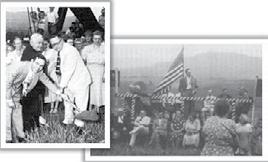
12 minute read
Over six decades, medical records have changed extensively
Editor’s Note: Sharleen Brady celebrated her 55th year at Fulton County Medical Center in March before retiring in May 2020. The Medical Staff Administrative Assistant sat down with Mike Straley, Executive Director of the Sharleen Brady FCMC Foundation, for an interview. She offered insight on a number of topics as then the longest-tenured FCMC employee, including working in the original building on First Street and the many changes she’s experienced over five decades.
Sharleen: When I first started at the hospital, there were only 25 people employed and you knew everybody. They had an old dumbwaiter (small serving tray system in an elevator shaft guided by pulleys and ropes) that meals came up on located across from the nurse’s desk. I remember one night, they sent up food for the 11 p.m. to 7 a.m. shift. They made chicken sandwiches. Someone put a whole chicken leg in one of the sandwiches (laughing).
Advertisement
Mike: Go back to when you admitted yourself when you were in labor.
Sharleen: There were nurses, but I did my own paperwork. It was so different then.
Mike: I talked to Ann Sheeley (DeShong) who was a registered nurse. One of the things that struck her was that it was an entirely different world, but it was such a good world, in her words. Everyone knew each other and everyone worked together and it wasn’t a case of “that’s not my patient.” If the patient needed help, you helped them.
Sharleen: We had 48 patients in the hospital lots of times and that included patients in the hallways. The hospital was licensed for 48 beds. The patients could stay as long as they wanted. There was a lady who stayed with us for three years. This was before Medicare. Back then, there was no long-term care. Long Term Care (nursing home) didn’t happen until 1976.
Mike: Why have you stayed for 55 years?
Sharleen: I love it here, I do. If my husband were living, I would’ve retired long ago. Every day was different and that’s a good thing. I enjoyed working with the medical staff.
Mike: Is this like your second family?
Sharleen: Yes. We had this one little tiny kitchen where they prepared all the food for everybody. At the end of it was this little room where you could go in and eat. The lab director would come in and eat and that’s where he came in the morning and got his bacon. At lunchtime you would come in and eat. It was a family atmosphere.
Mike: When there were plans to leave downtown to move up here (current Peach Orchard Road campus), there was a lot of doubt. What was your mindset?
Sharleen: I didn’t have any doubts about it. The hospital has always been here and it’s community-oriented. It was a big step to take, but it had to be done. There was no room for expansion; we were outgrowing what we had. We couldn’t go up or out. There was nowhere to go but to another location.
Mike: Was the old hospital an interior portion of the building that is now on First Street?
Sharleen: You couldn’t tell by looking at it now, but yes. In 1958, they added an addition to the original building. In 1970, they added a Solarium. In 1973, there was an ER and Lab expansion, which was finished in 1976. The additions changed the whole look of the original hospital.
Mike: What was the ER like back in the day?
Sharleen: It was one room staffed by local physicians. Whoever your doctor was, that’s who they called, until there was a call schedule set up. You came in and filled out a little card.
Mike: When you first started, you typed the X-ray reports. What did starting the medical records program entail?
Sharleen: Any record that was produced was put in a file box, all handwritten. Blue Cross came in and helped me get established with a filing system and a Dictaphone system. I didn’t go to school for medical records, I went to school for medical secretary. Dr. Lorentz dictated his X-ray reports.
Mike: Was he the first one to do that?
Sharleen: Yes. When we started the Medical Records Department, we started a filing system
2017
April 2017: Fulton County Medical Center Women’s Imaging Department acquired the newest technology in breast health with a 3D Mammogram. May 2017: – An $800,000 grant was awarded by the Appalachian Regional Commission and the Southern Alleghenies Planning and Development Commission to construct an access road that will open up the south side of campus for further development. October 2017: Phase One of CAM opens with MacDonald’s Pharmacy, Lobby, Fulton Family Practice, Specialty Services, Behavioral Health, IV Infusion, Cardiology/Pulmonology/Radiology.
FEB. MARCH APRIL MAY JUNE JULY AUG. SEPT. OCT. NOV. DEC.
Sept. 22, 2017: Jason Hawkins announces his resignation as CEO to take the CAO position for PeaceHealth Peace Harbor Medical Center in Florence, Oregon. Deb Shughart (CFO) and Kim Slee (COO) were named co-CEOs November 2017: The Community Health and Wellness Building opens to the public after renovations and construction of the former Dollar General were completed.
with the charts filed by number. The incomplete records were never completed. We started trying to get the doctors to complete their records. I remember there were filing cabinets in the hallway and there was a Dictaphone on top where they would dictate their reports.
Mike: Were you an army of one?
Sharleen: Until 1969, yes.
Mike: Did you take it upon yourself to do this?
Sharleen: I think that was the intent when I first came on. When I first started there wasn’t anything to do except type the X-ray reports, which were backlogged for months. They were typed on little 4x6 cards, very antiquated.
Mike: Two-part question: how did you find out about the position and what was the position that was advertised?
Sharleen: I worked for Dr. Lorentz on weekends while I was going to school. I typed X-ray reports while I was in his office. I found out between him and Mr. Strait, the administrator at the time. I also worked at the diner, and knowing him, he asked me to come in for an interview. The position was called Medical Secretary. The intent was for me to graduate into medical records. In 1974, I took my test for Registered Health Information Technician.
Mike: (Former FCMC CEO) Jason Hawkins has referenced many times how you’ve kept our Medical Center in good standing with your good work. Can you explain?
Sharleen: Blue Cross was our surveying agency and then Medicare came on. He is probably referencing when I came in while on maternity leave after four weeks because there was a state survey that needed my attention. I also assisted Dr. McLucas, Dr. Lorentz, Dr. Johnston, Dr. Villa and Dr. Witt with a lot of projects. I also assisted a couple of physicians with their board certifications.
Mike: How has your job evolved when you first started, say with the mimeograph, for example?
Sharleen: I came on board in 1965 and hired Freda Miller in 1969. Doris Simpson came in 1975-76 as a student and Joyce Peck did the same thing. When I left medical records, there were 10 employees. I left MR in 2007 to go to the medical staff position. I was at one time responsible for taking minutes of anything that happened -- nurse’s meetings, credentials, department head meetings, infection control, pharmacy, medical staff, medical executive, OB Committee meeting minutes, etc. Around 1973, the administrators said I would have to start prioritizing and have someone else help do it (taking minutes). They went from having no Medical Records department to keeping everything. It kept us all busy because we did all the X-ray reports and other reports that required typing.
Mike: When you started medical records, was that as a response to what was required through Medicare?
Sharleen: That was a state requirement. It was a requirement starting in 1966. Records had to be complete. Blue Cross just gave us direction on how to start the program. All of a sudden, we realized I had to do coding under ICD8, like it is now with ICD9. It was a challenge, but I would NOT have traded it for anything.
Mike: When you were starting Medical Records, how many hours were you logging?
Sharleen: At that time, I was only doing eight hours, but it wasn’t too long when I went to almost 50 hours a week with all the meetings. At times, we were backlogged with a lot of reports. Even after we put in a dictation system, we were backlogged with over 1,000 reports, including ER reports. The first dictation system started in 1986-87, with information being fed into four big tanks. It was quite an expensive project for the Medical Center.
Mike: When you started in 1965, did you have any idea this would be a career?
Sharleen: When I started, I promised two years, because the administrator thought I would get pregnant and leave. I got pregnant five years later. My first priority was becoming a nurse throughout my senior year of high school. I don’t know why I switched. I got accepted to the Maryland Medical Secretarial School in 1962. I knew I was getting married soon, and I didn’t think I’d stick around. I’ve always lived here in Fulton County. I grew up a half mile from where I live now.
Mike: Has it ever hit you that this is a pretty good gig, “I’m pretty lucky?”
Sharleen: I am very blessed. When my husband passed away in 2014, I don’t know what I would have done without the job or the people.
Mike: It doesn’t take a person long to realize that the people here are a cut above.
Sharleen: You say that now with all the numbers of staff we have, but 50 years ago we had 25 people, and it’s still the same way. We were a big family back then and it’s gotten much bigger. If someone had a baby shower or retirement, you were invited to the party.
Mike: There is concern out there sometimes that rural hospitals can’t make it with outside pressures. Were there times like that back then?
Sharleen: Yes, there were. We weren’t a Critical Access facility until 2001. We had gone through a period of time where we thought we were going to be bought out by another healthcare organization. It was a stressful time and there was fear among the employees. There were all sorts of rumors floating around. Through it all, the Board of Directors kept us independent. We lost our OB/GYN staff in 1989, and we changed surgeons every three years.
2018
March 2018: Both the Medical Center and its Long Term Care facility received a 4-star rating (out of a possible 5 stars) from The Centers for Medicare & Medicaid Services (CMS).
July 2018: Phase Four of CAM opens with expanded Physical, Occupational and Speech Therapies, Gift Shop and the Lunch Box Café.
FEB.
May 2018: Phases Two and Three of CAM open with Express Care, expanded Lab. MARCH APRIL
May 25, 2018: Michael Makosky named FCMC’s new President & CEO. MAY JUNE JULY AUG. SEPT. OCT. NOV.
Nov. 1, 2018: FCMC certified as a Level IV Trauma Center. DEC.
We were getting temporary folks in for OB. There was fear that was well-deserved. We didn’t know what was going to happen. I’m thankful we didn’t go with another organization and stayed independent all these years.
Mike: It’s definitely unique. Not a lot of folks have an independent medical facility.
Sharleen: We are very fortunate. Our community supports us, and they deserve the credit for it. We have a community that is willing to give to this hospital.
Mike: Speaking of community support, the response to the fundraising needs for the recent expansion with the Center for Advanced Medicine (CAM) was another example of the community rallying together.
Sharleen: The CAM Project was needed, and its impact has been very favorable. It has brought family practice under one roof and it’s now a unified practice. The extra services, like IV Infusion, Express Care and expanded services, like behavioral health and the therapies (PT/OT), just to name a few, have impacted this community. It has added at least 20 physicians to the roster through Specialty Services. And with the move of Specialty Services into CAM, that opened up space for dialysis care: a much-needed service in this community. Once again, the community responded financially for that project. The community amazes me. ■
CEServices, Inc. Medical Equipment Service Specialists

Charles V. Foust
W 814- 443 - 3194 C 814- 442 - 4279 177Springhill Lane • Somerset, PA15501

1DID YOU KNOW: Local residents and their fruitful fields lowered Fulton County Medi cal Center’s grocery bills in the early years of operation.
In the first year, for example, each student in every county school was asked to bring to the classroom one or more jars of canned fruits and vegetables or juices, which his/her parents felt they could spare. More than 1,000 jars of vitamin rich foods were placed on the shelves in the storeroom. When empty jars began to pile up, they were sent back home with the students for refills.
The newly formed Auxiliary oversaw this project, as well as canning 2 many of the fresh fruits and vegetables that came in without a jar. The first baby born at FCMC was Victoria Louis Cutchall of Hustontown, delivered by Dr. MacKinlay at 12:48 a.m. on Oct. 6. The baby’s mother arrived at 12:30 a.m. and Victoria was born 18 minutes later. She weighed 4 pounds, 12 ounces and was placed in an incubator. She stayed at FCMC for nearly three weeks after her mother was discharged on Oct. 10. Victoria lives in Breezewood.
3Over a span of two days in 1950, poisonous snakes had bitten three people. Prompt injection of the right kind of serum avoided death. When the serum supplies needed to be replaced, it was revealed that many of the other hospitals in the area did not make a practice of stocking it.
2019
April 1, 2019: Southern Huntingdon County Medical Center in Orbisonia became a member of the Fulton County Medical Center.
FEB. MARCH APRIL MAY JUNE JULY AUG. SEPT. OCT. NOV. DEC.
June 17, 2019: Dialysis Care Center opened its doors for the first dialysis patients in Fulton County. The community responded to the “Dollars for Dialysis” threemonth campaign as over $101,000 was raised for the construction and renovation of the former Specialty Services area that now houses the treatment center.







